gravity

challenges
- Use all the different pieces in a run to see what they do and how they work.
- Construct a run that goes for as long as possible. Time your run and record your time. How long did your run go for?
- Make a run that goes for exactly 10 seconds!
Motion is the science of moving things. If you lift a ball and drop it, it will fall to the ground. This is because gravity is pulling it to the Earth.
If we put the ball on a ramp it still wants to go straight down, but the ramp is in the way. Gravity is pulling the ball straight down but the ramp forces the ball to go across while it's being pulled down. Depending on how slanted the slope is, it will go faster or slower.
Friction is made whenever two things touch or rub together. The ball rubs against the ramp as it rolls and it will make the ball slow down. This is why a rolled ball slows down as it rolls and will not keep rolling forever.
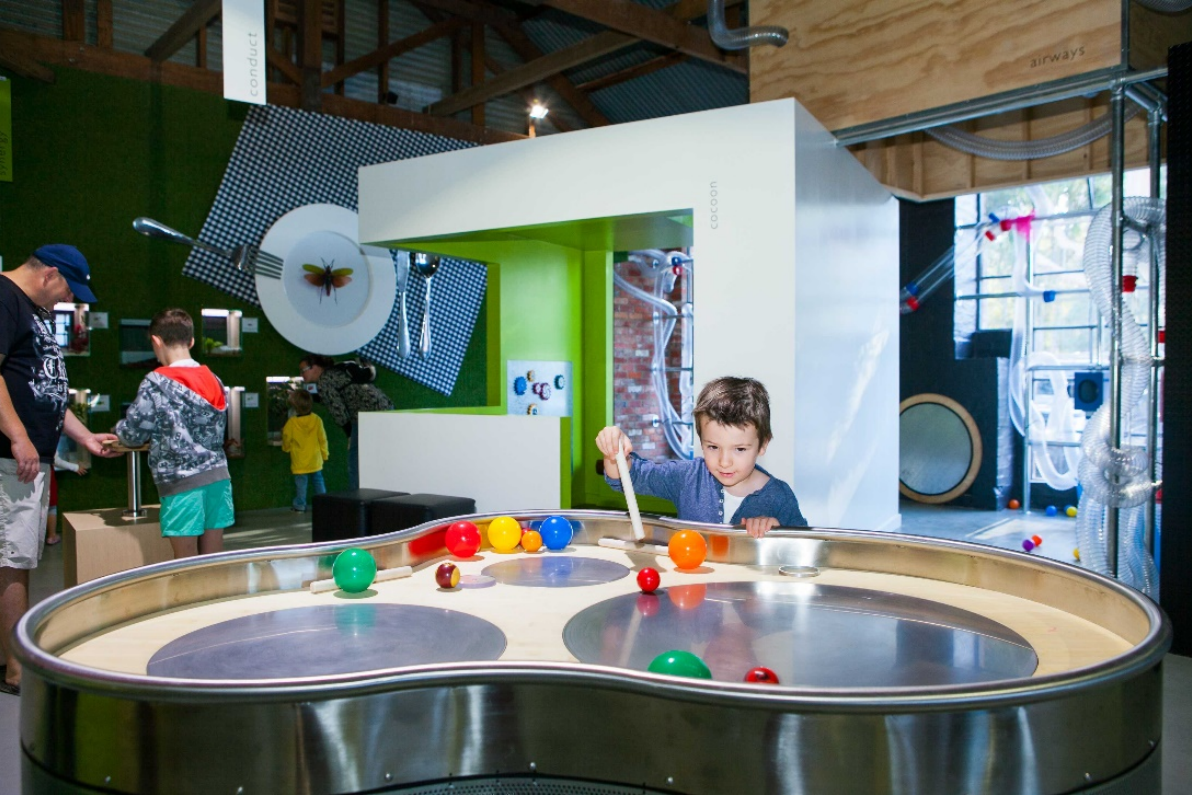
challenges
- Make a ring to roll upright on a spinning wheel.
- Roll a ball through an upright ring on a spinning wheel.
- Roll a ball across the spinning table so it gently hits the sides and bounces back onto a different wheel. Can you roll the ball around the table so it goes across all three wheels without you touching it?
Have you ever wondered why it is so much easier to stay on a bike when it is moving instead of still? This is because of something called angular momentum. Angular momentum is a force that acts on the spinning wheels of a bike to keep them upright. This helps the rider keep the whole bike upright.
Angular momentum is a special type of momentum that acts on spinning objects. Another type of momentum is linear momentum, often just called momentum. Linear momentum is the preference for moving things to continue to move in the direction they are moving.
Momentum would keep objects moving forever if there was no drag or friction to slow them down. On Earth, the air slows balls down by a force called drag, which is very similar to friction. In space there is no air so you could throw a ball and it would go forever, or at least until it ran in to a moon, asteroid, star, or planet.
An object's linear momentum is larger the faster or heavier an object is. This is why heavier or faster moving things are harder to stop - they have more momentum. Think about a big truck. Even if you take your foot off the pedal, it will continue to roll because it has momentum, and it wants to keep going the direction it is already going.

challenges
- Make a flying machine using one cup and 4 paper strips. Is it a good flyer? Make some changes and see what happens.
- Make a flying machine that spins.
- Make a flying machine which can touch the roof.
Wind is an important part of the eco-system of the Earth that you cannot see but can feel. Wind is air in motion and some wind, like the wind in a hurricane, can travel hundreds of kilometres an hour.
A cool fact about wind is that wind is an important part of the life cycle of plants. Wind picks up seeds from the parent plant and moves them to a new place far away which helps the plant spread to new areas. Many plant seeds have little wings that allow them to fly through the air. You could try to design a flying machine based on a flying seed design, or you can come up with your own!
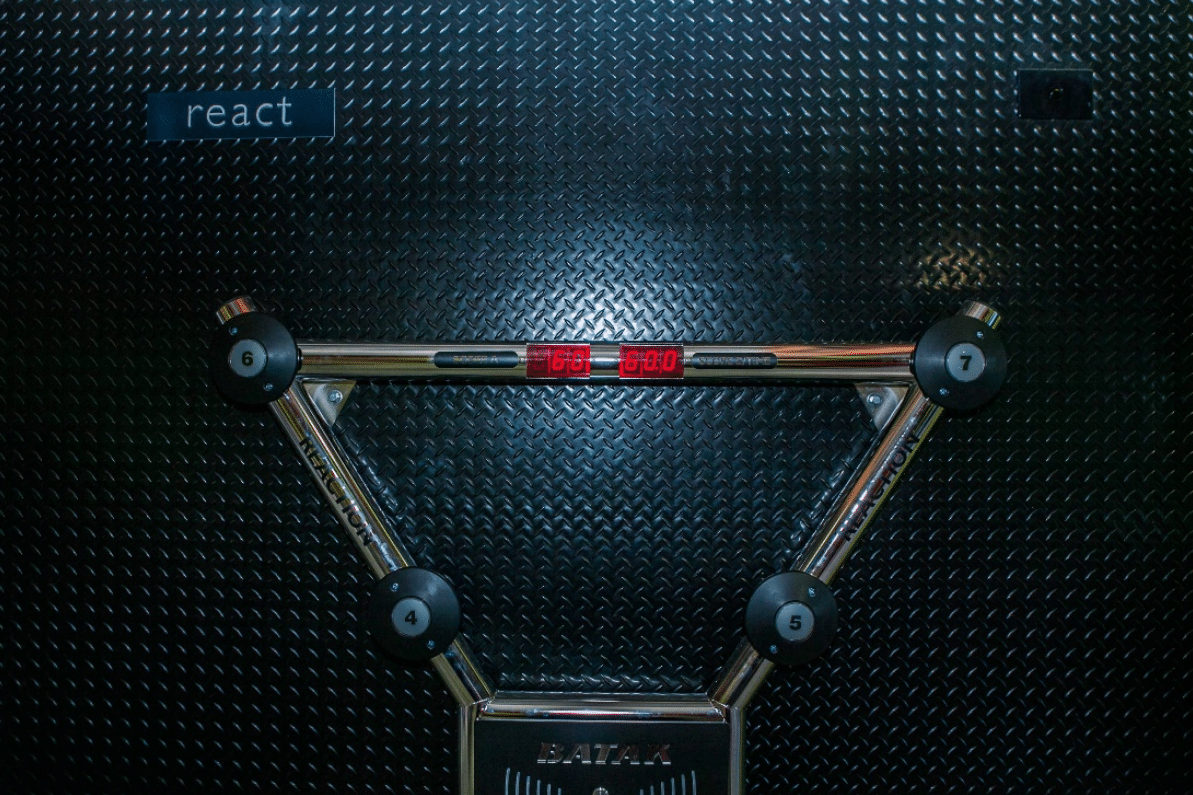
challenges
- How fast are your reaction times? As the numbers light up, tap them as fast as you can. Aim for a score of 30 in 30 seconds - that’s 1 point per second!
- Get a team of 2 and allocate half the lights each. This time aim for a score of in 30 seconds.
- Get 4 or more people. Can you get 60? Try and beat the record.
A reflex is a reaction to a situation that your body does without you having to think about it. There are lots of types of reflexes and most people have them, although some are faster than others. Reflexes include blinking (when someone throws something in your direction), ducking (when you hear a shout behind you) and jumping (when you hear a loud noise). These reflexes can protect you from dangerous things. If you put your hand on the stove, you will automatically move it away without thinking about it. Reflexes skip sending a message to the brain, and go straight to the spinal cord for faster responses. You can train your reflexes to be quicker and more accurate by practising things like catching fast moving balls, or playing fast paced video games. Test out your reflexes with react.

challenges
- Place 5 coloured balls into an opening while holding it open. Make sure one ball is different coloured to the rest. Your challenge is to catch the odd one out. Can you do it with the distraction of all the other balls? Good luck!
- Have 3 people stand at different boxes and put a ball in at the same time. Which is the fastest route?
- Put in as many balls as you like. Stand back with the bucket, and catch as many as you can.
Many living things have airways inside them. In mammals the airway attaches to the lungs which allows us to breathe. Humans need oxygen to breathe, which luckily is in the air all around us. This oxygen is made by plants, which convert the chemicals that we exhale (like carbon dioxide) into breathable air for us. This is why it’s so important for us to look after the plants around us and ensure they are here for our next generation.
Not all animals need air to breathe. For example fish have specialised lungs that allow them to breathe underwater called gills. Have you ever thought about your airway and how you breathe?

challenges
- See if you can make it rain!
- Can you make a map of Australia?
- See if you can change how a river runs and how the change of direction affects the surrounding environment.
The land around us has changed many times, as the Earth has gotten older. Changes in environmental factors and extreme weather conditions have forged the way the world looks today and will continue to do so for years to come.
Echuca is on the banks of the great Murray River but rivers, like all aspects of the environment can change over time. The width and direction of the river can change, as well as the strength of the current, and the wildlife that live in the riverbanks.
Contours is an exhibit that shows you how contours on a map work. Contour maps are used to show the height of a map. Each line is at the same height. If the lines are close to each other it means that the slope is steep and if they are far apart the slope is more flat. Contours updates the contour lines as you move the sand around.
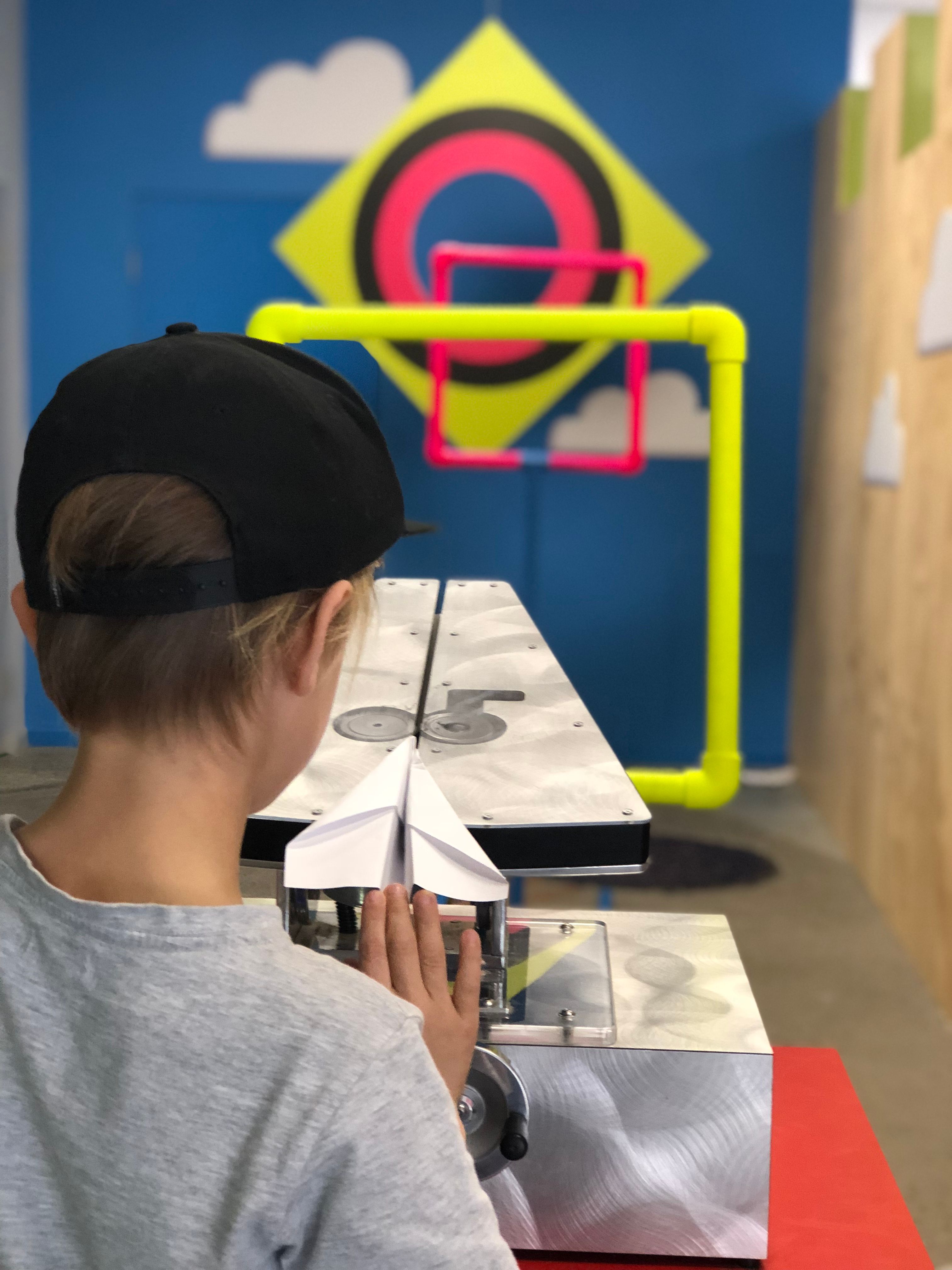
challenges
- Make a paper plane that hits the target using launch.
- Make a paper plane that goes through the hole in the target.
- Make a paper plane that can hit the back wall.
- Make a paper plane that goes through the target and hits the back wall.
To make a paper plane that can fly a long way we need to understand the forces that affect flying planes. The main forces are thrust, drag, lift and gravity which each work in different directions.
- Thrust is the forward pushing force, in our case, it is made from the launch machine.
- Drag is the friction that is caused by the air rubbing against the plane, and it slows down the plane.
- Gravity pulls the paper plane down towards the ground and
- Lift, well, lifts the plane up.
Normally you would have to throw a paper plane to produce thrust, but launch provides the thrust for you!

challenges
- Using a single cube, make it play 4 different sounds.
- See if you can use two cubes to make a song.
- Use all the cubes to make a song!
Sound waves are what we call longitudinal waves. They are created by air being compressed and expanded in waves. You can see a representation of the sound waves being generated connecting the reactable cubes to the centre dot. Each of the cubes play different loops when placed on the reactable surface.
The volume is controlled by dragging the dot next to the cube up or down. If the line towards the centre dot is a dashed line, press on it until you see the sound waves moving. If the dot is orange, you need to flick it away from the cube, and you will be able to change the volume. There is a large number of different samples you can use, play with the settings by clicking and dragging the gear at the bottom.
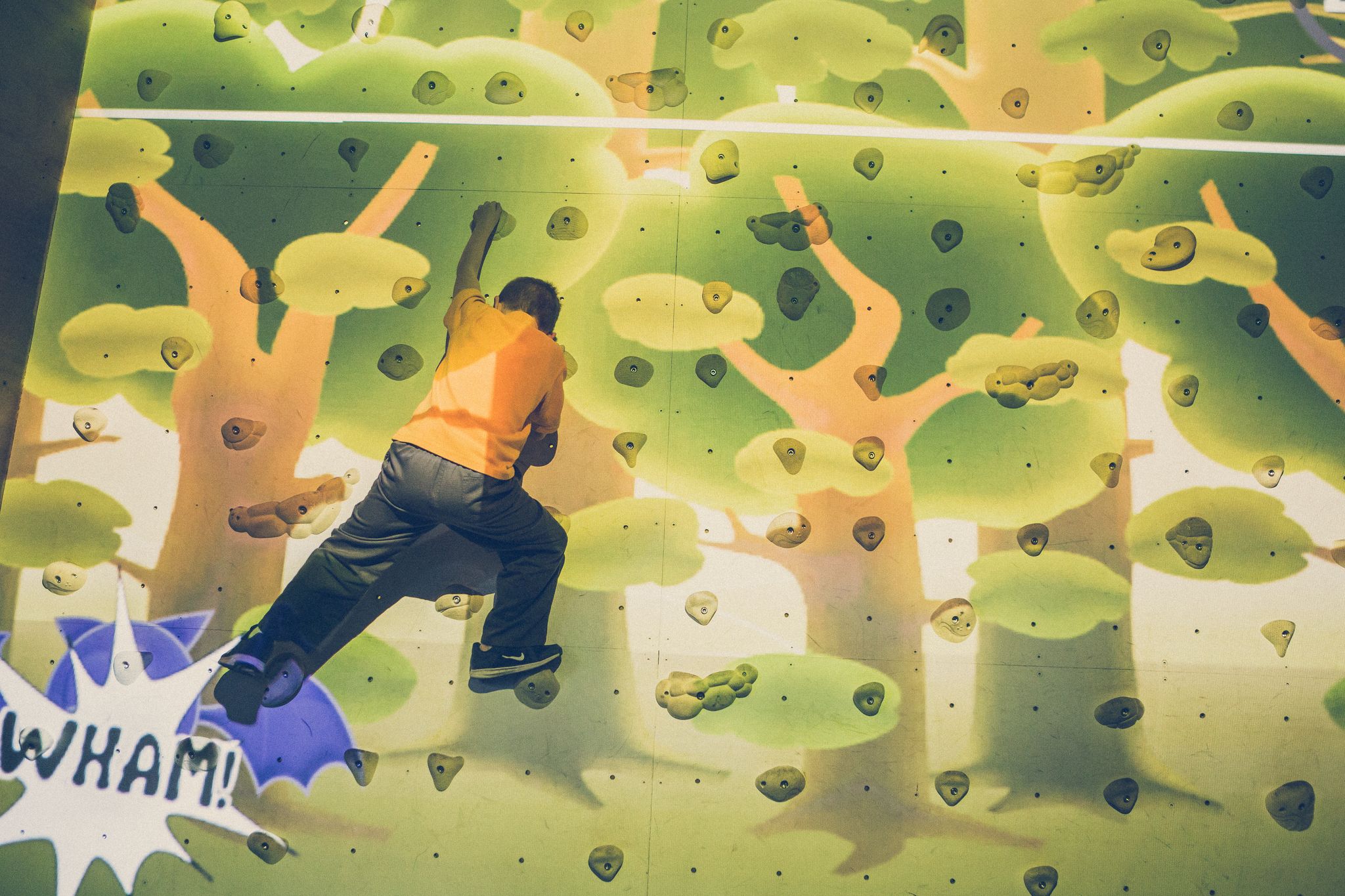
challenges
- Try to get the highest daily score on Whack-a-bat or Sparks.
- Try to get the highest weekly score on Whack-a-bat or Sparks.
- Try to beat a friend in Hullaballoon or Climball.
Climb is an exhibit all the way from Finland! It uses augmented reality so you can rock climb and play games at the same time. Augmented reality is sometimes confused with virtual reality. Augmented reality superimposes projections or images on to the real world, whereas virtual reality creates an entirely digital world.
The cool thing about augmented reality is that you can interact with digital objects while still being in the real world!

challenges
- Gently flick the dial and see where it lands.
- Count the number of animals you can see in all the videos.
- Try to find the dog catching a frisbee.
- Try to find the bottle exploding.
- How many different videos are there?
When you watch videos or TV, did you know we are actually watching a series of still images displayed in quick succession? The brain links them together to form a consistent motion video. The earliest form of a moving image is the zoetrope, which rotates a series of images that make up a loop when viewed through slits on the zoetrope. Also, when you zoom in really close up on the TV, you will see the images are actually made up of different combinations and intensities of little red, blue and green pixels which form the wide range of colours we see on the screen.
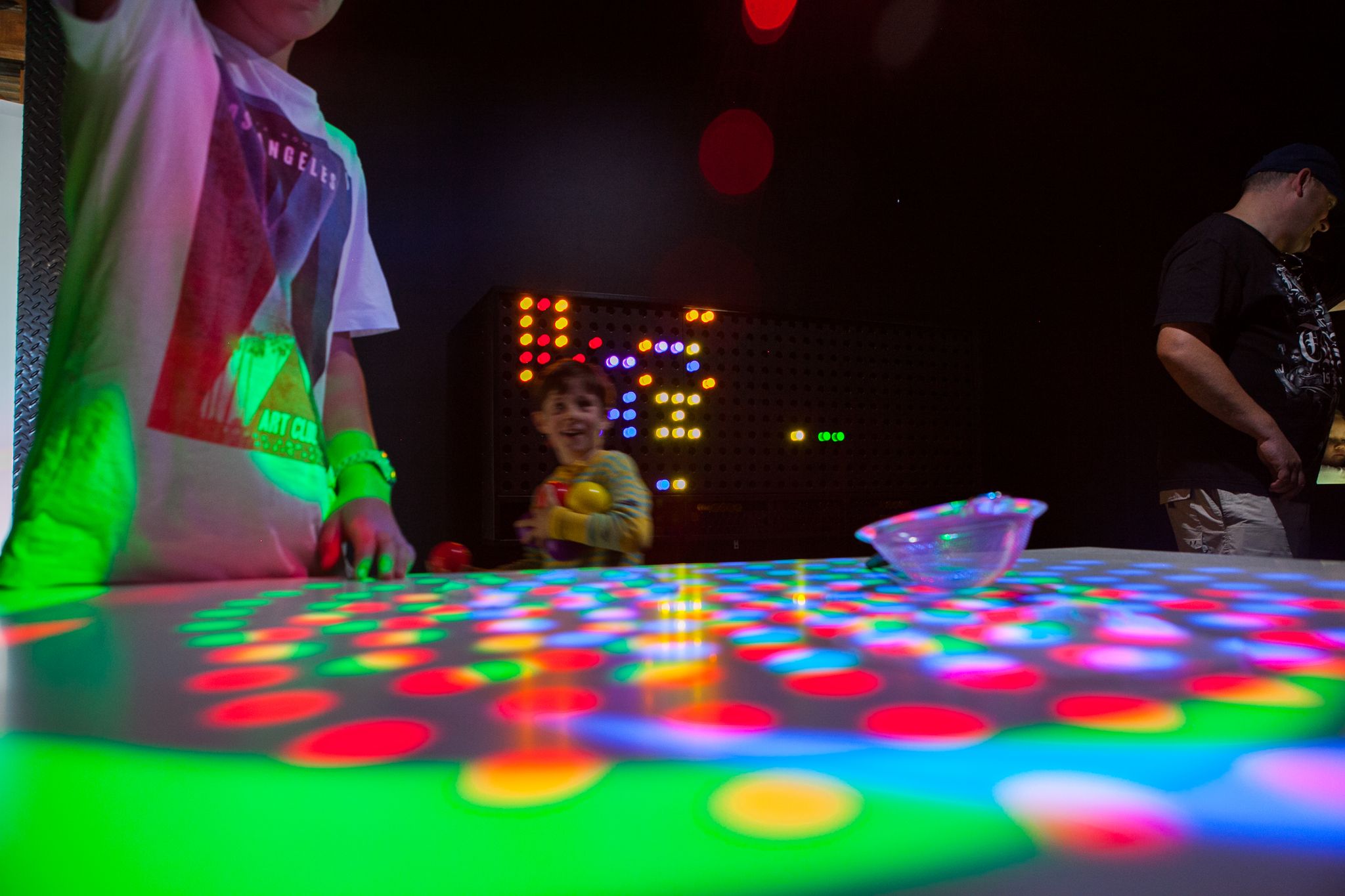
challenges
- Can you make a shadow that is red and green?
- Can you make a shadow that is green and blue?
- Can you make a shadow that is red, green and blue?
Light from the sun (white light) is made up of all the colours of the rainbow. When the colours are combined, the light appears to be white. Shadows is made up of three coloured globes, Red, Blue and Green, (Primary Colours) hanging above the table. Where the three coloured lights mix on the centre of the table, the light appears to be White. Further out on the table, where only two lights mix, you will see the secondary colours: yellow, cyan and magenta. On the outer edge are the three primary colours. Shadows are made when light is blocked. They usually appear black or dark because all light is being blocked. In the case of the shadows exhibit, the shadows you make are different colours depending on which light you are blocking!

Honey bees have a very intricate social organisation, with three main roles. The queen bee is usually the mother to every other bee in the hive, the largest and only bee laying eggs. The other bees tend to her and will follow her if she is relocated. Potential queens must fight to the death to achieve the role! The bees that are in charge of every other area of the hive are called worker bees, and are all female. Their roles include feeding larvae, foraging, building the hive, preserving honey and storing pollen. They only live for about a month, and are busy bees their whole lives! Finally, the drone bees, who are all male and assist in reproduction with the queen. They form from unfertilised eggs and are fed by the worker bees.
Honey bees visit flowers to collect nectar and pollen. Nectar is a sweet liquid produced by the plant when it performs photosynthesis and it attracts bees and other insects. Pollen is produced by the male part of a plant and used to breed with other plants. When bees collect nectar and pollen, they also transport pollen and help to pollinate and fertilise the plants! Back at the hive, bees process nectar into honey, which is stored as a food source. Pollen is also processed to be mixed with honey and processed again to become food for the larvae.
Bees obviously can't speak like humans, so how do they communicate? They do it through dance, or 'waggling'! Honey bees use a complicated figure-eight dance to indicate the direction and distance of important things like flower patches, water sources and possible sites for a new nest.
The hive at TwistED Science has a passageway which allows the bees to go outside and collect both nectar and pollen from the eucalypts, and water from the Murray River! On your way out, look for their entrance on the roof.
